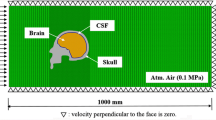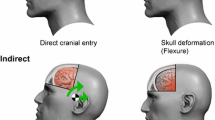Abstract
Purpose
The role of ear canal in transmitting blast waves to the brain is not clear. The goal of this work is to characterize the influence of ear canal on blast-induced mild traumatic brain injury through a computational approach.
Methods
A three-dimensional human head model with single-side ear canal details was reconstructed from computed tomography images. The ear canal was positioned either facing the incident blast wave or facing away from the blast wave.
Results
The blast wave-head interaction has demonstrated that the overpressure within the ear canal was substantially amplified when the ear directly faced the blast wave. When it faced away from the blast wave, the overpressure within the ear canal was less than the actual incident blast pressure. Regardless of the substantial pressure differences within the ear canal induced by the blast wave, the resulting intracranial pressures were almost the same for both cases.
Conclusions
The blast wave-head interaction has demonstrated that the role of the ear canal in brain dynamics, and thus brain injury, was negligible. However, the peak overpressure within the ear canal exceeded the documented tympanic membrane rupture and inner ear damage thresholds. This was speculated to cause the degeneration of axons along the auditory pathway up to the midbrain. This work provided fundamental understanding of the load transmission through the ear canal and could serve as a platform for designing better protective armors.
Similar content being viewed by others
References
Warden D. Military TBI during the Iraq and Afghanistan wars. J Head Trauma Rehabit. 2006; 21(5):398–402.
Kleinschmit NN. A shock tube technique for blast wave simulation and studies for flow structure interactions in shock tube blast experiments. Masters thesis; University of Nebraska-Lincoln; USA; 2011.
Moss WC, King MJ, Blackman EG. Skull flexure from blast waves: a mechanism for brain injury with implications for helmet design. Phys Rev Lett. 2009; doi:10.1103/PhysRevLett.103.108702.
Courtney AC, Courtney MW. A thoracic mechanism of mild traumatic brain injury due to blast pressure waves. Med Hypotheses. 2009; 72(1):76–83.
Hua Y, Akula PK, Gu L, Berg J, Nelson CA. Experimental and numerical investigation of the mechanism of blast wave transmission through a surrogate head. J Comput Nonlin Dyn. 2014; doi:10.1115/1.4026156.
Mao JC, Pace E, Pierozynski P, Kou Z, Shen Y, VandeVord P, Haacke EM, Zhang X, Zhang J. Blast-induced tinnitus and hearing loss in rats: behavioral and imaging assays. J Neurotrauma. 2012; 29(2):430–44.
Arun P, Valiyaveettil M, Biggemann L, Alamneh Y, Wei Y, Oguntayo S, Wang Y, Long JB, Nambiar MP. Modulation of hearing related proteins in the brain and inner ear following repeated blast exposures. Interv Med Appl Sci. 2012; doi:10.1556/IMAS.4.2012.3.2.
Varas JM, Philippens M, Meijer S, Van Den Berg A, Sibma P, Van Bree J, De Vries D. Physics of IED blast shock tube simulations for mTBI research. Front Neurol. 2011; doi:10.3389/fneur.2011.00058.
Alley MD, Schimizze BR, Son SF. Experimental modeling of explosive blast-related traumatic brain injuries. Neuroimage. 2011; doi:10.1016/j.neuroimage.2010.05.03.
Zhu F, Wagner C, Dal Cengio Leonardi A, Jin X, VandeVord P, Chou C, Yang KH, King AI. Using a gel/plastic surrogate to study the biomechanical response of the head under air shock loading: a combined experimental and numerical investigation. Biomech Model Mechanobiol. 2012; doi:10.1007/s10237-011-0314-2.
Akula P. Blast induced traumatic brain injury: role of ear openings. Masters thesis; University of Nebraska-Lincoln; USA; 2013.
Ganpule S, Gu L, Alai A, Chandra N. Role of helmet in the mechanics of shock wave propagation under blast loading conditions. Comput Methods Biomech Biomed Engin. 2012; doi:10.1080/10255842.2011.597353.
Abaqus benchmark manual. Providence; Rhode Island; USA; 2008.
Zhang L, Yang KH, Kin, AI. Comparison of brain responses between frontal and lateral impacts by finite element modeling. J Neurotrauma. 2001; 18(1):21–30.
Sundaramurthy A, Alai A, Ganpule S, Holmberg A, Plougonven E, Chandra N. Blast-induced biomechanical loading of the rat: an experimental and anatomically accurate computational blast injury model. J Neurotrauma. 2012; doi:10.1089/neu.2012.2413.
Chafi MS, Dirisala V, Karami G, Ziejewski M. A finite element method parametric study of the dynamic response of the human brain with different cerebrospinal fluid constitutive properties. Proc Inst Mech Eng H. 2009; 223(8):1003–19.
Hua Y, Akula P, Gu L. Experimental and numerical investigation of carbon fiber sandwich panels subjected to blast loading. Compos Part B Eng. 2014; 56(1):456–63.
Nahum AM. Intracranial pressure dynamics during head impact. Conf Proc Stapp Car Crash. 1977; doi:10.4271/770922.
Chen Y, Ostoja-Starzewski M. MRI-based finite element modeling of head trauma: spherically focusing shear waves. Acta Mech. 2010; 213(1):155–67.
Morest DK, Bohne BA. Noise-induced degeneration in the brain and representation of inner and outer hair cells. Hear Res. 1983; 9(2):145–51.
Zalewski T. Experimentelle Untersuchungen uber die Resistenzfahigkeit des Trommelfells. Z Ohrenheilkd. 1906; 52(1):109.
James DJ, Pickett VC, Burdette KJ, Cheesman A. The response of the human ear to blast, part 1: the effect on the ear drum of a short duration, fast rising pressure wave. AWRE/CDE Report No. 04/82; 1982.
Keller AP. A study of the relationship of air pressure to myringorupture. Laryngoscope. 1958; 68(12):2015–29.
Hirsch FG. Effects of overpressure on the ear: a review. Ann N Y Acad Sci. 1968; 152(1):147–62.
Richmond DR, Yelverton JT, Fletcher ER, Phillips YY. Physical correlates of eardrum rupture. Ann Otol Rhinol Laryngol Suppl. 1989; 140(1):35–41.
White CS, Bowen IG, Richmond DR. The relation between eardrum failure and blast-induced pressure variations. Space Life Sci. 1970; 2(2):158–205.
Kringlebotn M. Rupture pressures of membranes in the ear. Ann Otol Rhinol Laryngol. 2000; 109(10):940–4.
Author information
Authors and Affiliations
Corresponding author
Rights and permissions
About this article
Cite this article
Akula, P., Hua, Y. & Gu, L. Blast-induced mild traumatic brain injury through ear canal: A finite element study. Biomed. Eng. Lett. 5, 281–288 (2015). https://doi.org/10.1007/s13534-015-0204-0
Received:
Revised:
Accepted:
Published:
Issue Date:
DOI: https://doi.org/10.1007/s13534-015-0204-0




